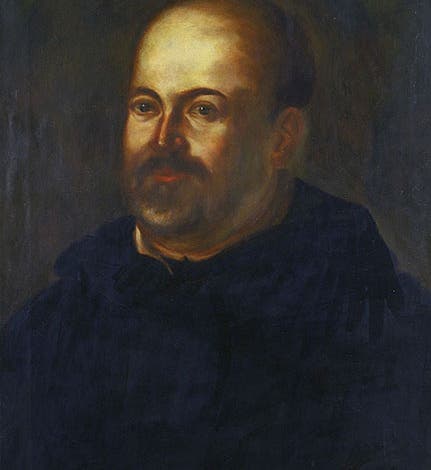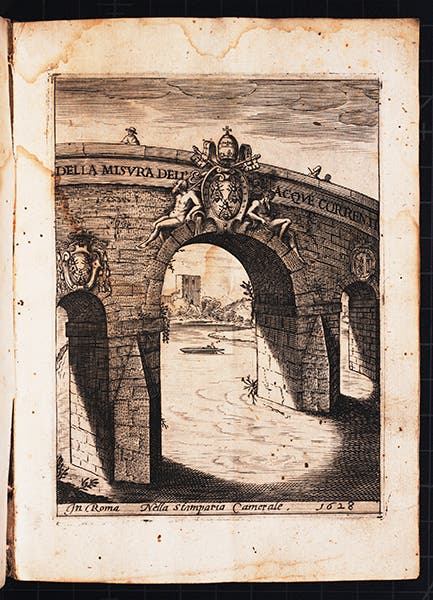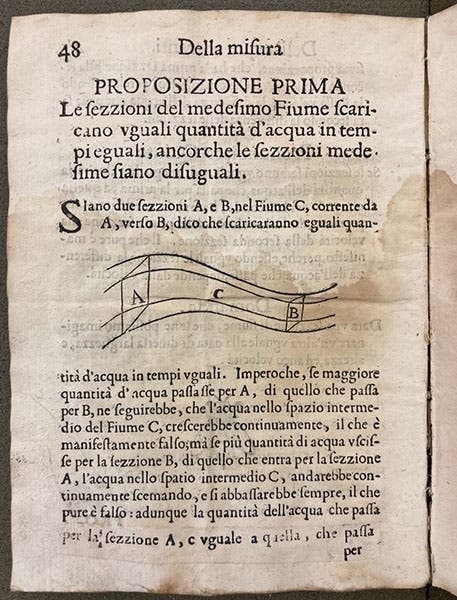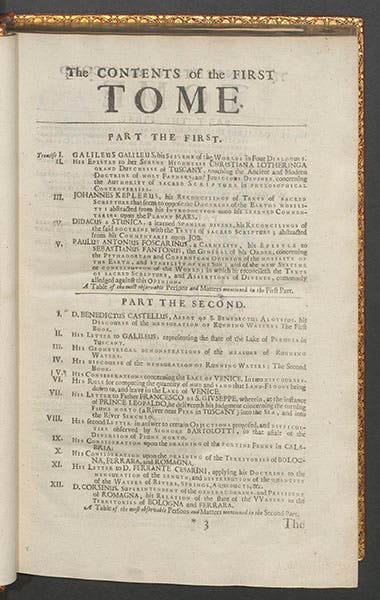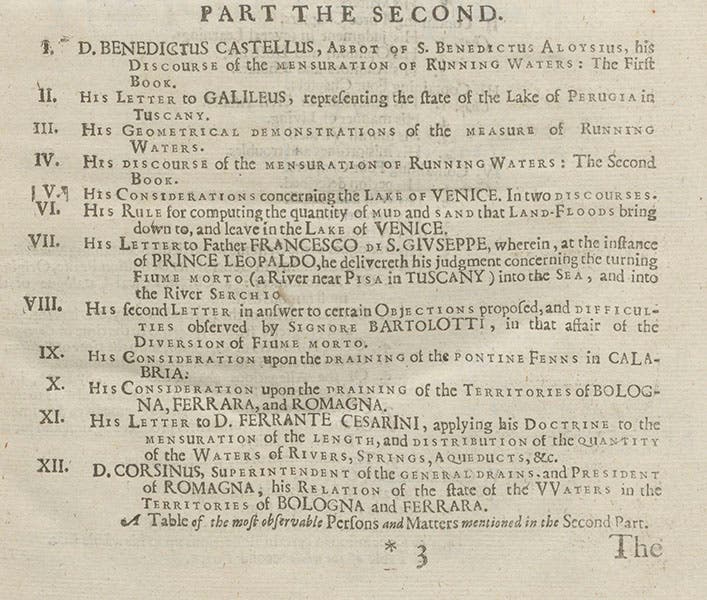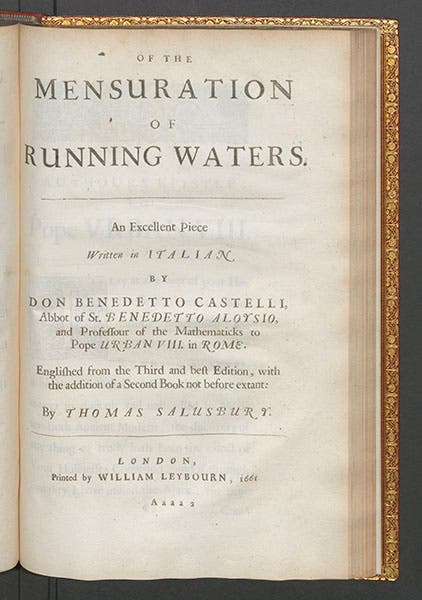Scientist of the Day - Benedetto Castelli
Benedetto Castelli, an Italian Benedictine monk and mathematical scientist, was born sometime in 1578, in Brescia, in northern Italy. He entered the Benedictine order at Monte Cassino in 1595, when he was 17. He was in Padua in March of 1610 when Galileo Galilei, a teacher at Padua, published his Sidereus nuncius, announcing that the moon has mountains and Jupiter has moons. Almost instantly, Castelli found his second calling in life, following and supporting Galileo. He wrote Galileo a letter in December of 1610, asking whether Venus, through the telescope, showed phases like the Moon. Several days later, Galileo announced (in a cipher to Johannes Kepler) that Venus exhibited phases, evidence that it orbited the Sun, without mentioning Castelli. But he more than repaid Castelli when, after Castelli finagled a transfer to Florence to be nearer his hero, Galileo recommended him for the post of professor of mathematics at Pisa, a post that Galileo once held himself. It is possible that Galileo also facilitated Castelli's introduction to the Medici court, which Castelli would serve for many years.
The same year that Castelli secured his professorship, on today's date, Dec. 21, 1613, Galileo wrote Castelli a letter. A week before, Castelli had written Galileo with an account of an evening he had spent at the Medici court, during which the subject of Copernicanism and its compatibility with Scripture had arisen, as had Galileo's name. Since several of his opponents were in attendance, Galileo was slightly alarmed at what might have been said, and he wrote Castelli to set the record straight. This letter was Galileo’s first foray in writing into the subject of science and religion. He argued that Scripture is an infallible guide to salvation, but it is often silent on matters of science, for which Nature must be our guide. He set forth his belief that the Bible was written in a language that would accommodate the understanding of the ordinary person, and thus such statements as "Joshua made the sun stand still" were not intended to be taken literally and are not evidence against a heliocentric cosmology. The “Letter to Castelli” marks the beginning of what is often called "the Galileo affair," the twenty- year saga that culminated in Galileo's trial for heresy in 1633. The “Letter to Castelli” was not printed as such at the time, as letters like this often were, but it was later expanded into the Letter to the Grand Duchess Christina, 1615, which was printed, although not until 1636.
As important as Castelli was as a booster and defender of Galileo, he made his own mark in the scientific world. He was the founder of the science of "running water," or hydrodynamics, just as Archimedes had been the founder of hydrostatics. For centuries, court engineers had been building aqueducts, diverting rivers, and supplying water to fountains and gardens, without having any real understanding of the factors that affect the rate of flow of water in pipes or river beds. Many engineers thought, for example, that water flowing from a height at point B, down to point A, would flow faster if the route from A to B were direct, rather than stretched out in a long wandering channel. Castelli understood that the height difference of A and B is the only factor that affects the amount of water flow. He also discovered a law, often called the law of continuity, requiring that the cross-sectional area of a river times the water velocity be a constant, so that if the river is constricted (by a narrowing, for example) then the water flow will increase accordingly (third image). And he determined that the height of water flowing in an inclined canal is proportional to the square root of the quantity of water flowing in. He did for water flow what Galileo had already done for balls rolling down planes – discovered the basic mathematical laws that determine the quantity and motion of flowing water. In 1628, Castelli published a book on the subject that he had made his own: Della misura dell'acque correnti (On the Measure of Running Water; second image). It is the first book on water flow to have a mathematical basis. We have a fine copy of this book in our collections. Castelli later wrote a second part, and some further considerations, which were included in a much-expanded edition published in 1660. We have that edition as well.
In 1626, Castelli was invited by Maffeo Barberini (now Pope Urban VIII, and not yet Galileo's adversary) to be the Barberini court adviser on hydraulic matters. So Castelli left Pisa for Rome, where he became professor of mathematics at the Sapienza, the University of Rome. In 1641, Castelli was invited to consult on the problem of the lagoon of Venice, which had been silting up. Venetian engineers had decided that rivers feeding the lagoon were bringing in the silt, and they had already diverted some of the rivers and were in the process of diverting others. Castelli told them that river inflow was the solution, not the problem – that the inflowing water scoured the lagoon, and without the additional waterflow, the silting was just going to get worse. As a mathematician trying to counter centuries of tradition, Castelli was ignored by the Venetian authorities. But he was right.
Castelli’s reputation in the mid to late 17th-century as a Galilean experimental scientist was quite high. That reputation is demonstrated by the contents of Thomas Salusbury’s two-volume Mathematical Collections and Translations (1661-1665). Volume 1 begins with an English translation of Galileo’s Dialogue on the Two Chief World Systems, first published in Italian in 1632, followed by Galileo’s Letter to the Grand Duchess Christina and letters by Kepler and others on scripture and Copernicanism.
Part 2, which follows immediately, is a collection of 12 documents on running water, 11 of which are by Castelli, including a translation of his book on running waters, the full work from the 1660 edition. Since it is not generally appreciated that Castelli’s works were included in Salusbury’s book, we show here the table of contents of volume one; a detail of the contents of Part 2; and the title page of the translation of Castelli’s book on running waters (fourth, fifth, and sixth images), all from Salusbury’s compilation of 1661;
Castelli, while at Pisa, was the teacher of Evangelista Torricelli, and while in Rome, the mentor of Bonaventura Cavalieri, two of the most prominent of the next generation of Galilean scientists.
One would like to know more about the one surviving contemporary portrait of Castelli, which apparently is in the Museo Galileo in Florence, but might only be on their website, and located elsewhere (first image).
Dr. William B. Ashworth, Jr., Consultant for the History of Science, Linda Hall Library and Associate Professor emeritus, Department of History, University of Missouri-Kansas City. Comments or corrections are welcome; please direct to ashworthw@umkc.edu.

